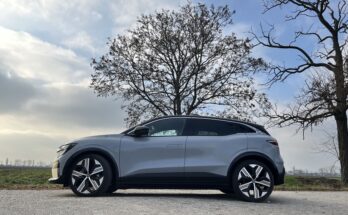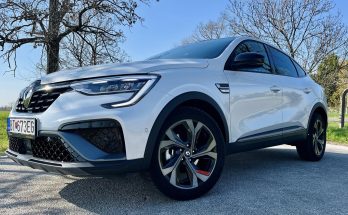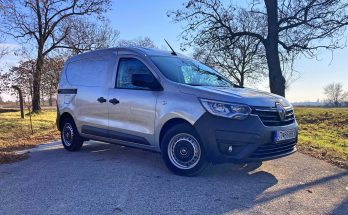Renault Captur has long been among the best-selling models in its class. In the test, we will try to find out what it owes to. At the end of its "career", the Captur received a powerful engine and sporty S-Edition equipment. We will try it with the 150-horsepower 1.3 TCe engine and automatic transmission.
From the outside
In 2017, Captur underwent a facelift. Small changes to the front bumper were enough and the look of the car changed radically. The front part makes a strong impression, especially thanks to the large and effectively curved LED daytime running lights at the bottom, which tastefully surround the small fog lights. The manufacturer's distinctive emblem is nicely embedded in the radiator grille and protrudes into the space. The short front hood continues at almost the same angle to the high windshield.
A side view reveals the rich glazing of the car and imaginative moldings on its doors. The black coating of the lower part of the door with a chrome strip optically increases the car's ground clearance (170 mm) and makes it slimmer. I like the design of the C-pillar, on which the blue fender blends and the continuation of the black roof. Nice 17" rims (with 205/55 R17 tires) reveal drum brakes on the rear wheels, which don't really suit the relatively powerful engine.
The rear part is decorated with a distinctive black spoiler, which effectively ends the roof of the same color. Small but distinctive rear lights with a nice signature extend into the sides of the body. The massive rear bumper is complemented by tasteful silver protection. In my opinion, the design would be helped by an admitted exhaust with a nice end.
The blue color of the car fits, the black roof disappears a little in this combination.
Inside
After opening the doors, I noticed decent seals on their sides, which promises a decent soundproofing from aerodynamic noise. The interior of the doors is of high quality and nicely finished, including the buttons for controlling the windows and rear-view mirrors. I was also positively surprised by the honest overlap of the thresholds.
The deep dashboard is made of a combination of hard and soft materials, which is rather a rarity in this category of cars. The dark upholstery of the pillars and the roof underlines the character of the sporty S-Edition equipment.
In my opinion, the Captur could use a sports steering wheel, at least in this configuration. Its shape shows the design approach of previous generations of Renault vehicles. The steering wheel has too much center and four buttons controlling the cruise control. The audio system is controlled by a separate lever under the steering wheel.
The center console, covered in piano lacquer, protrudes into the space. The unnaturally placed infotainment display and the strangely arranged control elements of the automatic climate control, similar to the steering wheel, are reminiscent of times gone by. The instrument panel would also deserve an upgrade. On the other hand, however, I appreciate its clarity and, except for the missing coolant temperature indicator, enough information provided.
The central tunnel is set relatively low. I was interested in the start button located at the beginning of it and also the nicely designed selector of the automatic transmission. The material of the seats is a nice combination of solid fabric, leather and alcantara. At first glance, their distinctive shape promises an excellent sitting position behind the wheel.
Driving
The seats did not disappoint. The seats are averagely long, but wide enough and the backrests are reasonably high. The back is perfectly supported, including the lumbar part. In the lower position of the seats, you sit pleasantly low. The legs are stretched forward, the layout of the aluminum pedals is exemplary, and the left leg rest is richly dimensioned. There is generally enough legroom. Perfection lacks the possibility of an even greater range of steering wheel adjustment and pulling it closer to the driver's body. I was completely satisfied with the space in the shoulder area and above the head.
Despite my reservations about the design of the steering wheel, I have to highlight its thick rim and above all its perfect shaping in the grip area. Its protruding inner parts are gently turned towards the driver, which allows it to be wrapped naturally in the palms.
The ergonomics of the controls are good despite their unusual shape, they are handy and logically located. However, the unlit cruise control buttons on the steering wheel were a problem for me at night. The armrest is attached to the driver's seat and its size is intended only for him. However, it is positionable and fulfills its role sufficiently.
The infotainment control is quite intuitive and the screen responds quickly to touches. I appreciated Android Auto support and thus Waze navigation. The excellent view in all directions was spoiled by thick A-pillars and relatively small rear-view mirrors for crossovers.
Ride
Already after the first kilometers of driving, I appreciated the excellently tuned chassis of the car. Its palpable stiffness was balanced with its ability to filter bumps. It takes turns with little lean and with great confidence. I was pleasantly surprised by the simple rear axle, which was able to keep the wheels in the right position on the road even when going over bumps. The search for the limit, however, is hindered by a too rigidly adjustable stabilization system, but you can still have a good time with the car.
I was also satisfied with the steering, which is sufficiently direct and without play around the central axis. The effect of the booster is adequate and provides the same resistance in every position of the steering wheel.
The car was powered by a new four-cylinder gasoline engine with a volume of 1332 cm 3 , a maximum power of 110 kW at 5000 rpm and a torque of 250 Nm at 1700 rpm. The engine provides a smooth pull from 2000 to 6000 rpm without a hint of wilting, but also without a power peak. It can accelerate over 150 km/h without any problems. At low revs it has a nice rough sound, at higher revs it turns into an ugly tinny sound. The reaction to the movement of the gas pedal is quite brisk, while it is supported by the quick gearshift of the automatic.
It is a dual-clutch EDC transmission with six gears. Its advantages include smooth shifting and the absence of jerking and jerking when starting from a standstill. I also appreciated the logical downgrading when gradually reducing speed, e.g. before the bend. However, I wasn't entirely satisfied with the logic of her shifting in certain situations. It often happened that when a sudden acceleration was needed (on kickdown) the transmission shifted too low and the revs reached 5500. Of course, this caused the transmission to upshift again about half a second later. When going uphill, on the other hand, she left the gear too high and thus kept the revolutions below 1500. Each such, or however, a similar situation could be solved by the correct position of the accelerator, or by the speed at which it is pressed. It is important to get used to the gearbox and thus avoid its shortcomings.
The turning diameter of 10.8 m guarantees good controllability of the car in city streets. However, I would welcome fewer revolutions between the extreme positions of the steering wheel (2.7). The image from the camera on the infotainment display is not of the highest quality, but together with the sensors on the sides of the vehicle, it certainly makes parking easier. I was able to keep consumption at 7.5 l/100 km in average traffic.
Thanks to the excellent chassis and powerful engine, I was able to enjoy Okresky. When working correctly with the gas pedal, the transmission used the entire range of usable revolutions. The use of drum brakes was not noticeable in their effect, but in the case of the need for vigorous braking, it was necessary to exert a relatively large force on the pedal. When driving at night, I was satisfied with the performance of the front LED lights, whether in low or high beam mode. In the pursuit of low consumption, I was able to reduce it to a value of 5.7 liters. During normal brisk driving, it increased to 6.1, aggressive driving pushed it to the level of 7.4.
I was surprised by the low level of aerodynamic noise on the highway. The engine did not bother with its sound even at a speed of 130 km/h, on the contrary, the noise from the chassis was more pronounced. Driving at higher speeds was generally comfortable and resembled cars min. one class higher. Consumption was around 8 at a speed of 130-140 km/h, the expressway with a speed limit of 100 km/h reduced it to 5.5.
I handed over the car with an average consumption of 6.8 l/100 km. I drove briskly on the whole with a predominance of highways. Considering the higher build of the car and the relatively powerful engine, I consider the achieved consumption to be adequate. With a fuel tank volume of 45 l, the car can travel more than 600 km on one refueling.
In the table below, I show the engine speed in sixth gear at individual speeds.
| Speed in km/h | RPM per min. |
| 100 | just over 2,000 |
| 110 | 2300 |
| 120 | 2500 |
| 130 | 2700 |
| 140 | 3000 |
| 150 | 3150 |
Practical side, price
With my height of 185 cm, I could not sit comfortably "behind me" due to the lack of legroom. However, children and persons of shorter stature will not experience a problem with the space. The rear door opens to a wide angle, making it easier to get in and place the child in the seat. I highlight the perfect location of the IsoFix mounts and the "plastered" rear part of the front seats.
A funny-looking drawer instead of an opening cabinet in front of the passenger makes it possible to put away even larger objects. The smaller ones find their place in the armrest, door panel, on the dashboard, center tunnel or in front of the automatic selector.
The luggage compartment provides a relatively large basic volume of 377 l, with full use of the double bottom and rear seats, even 455 l. Folding the rear seats increases it to 1235 l.
The price of the Captur in the top S-Edition trim, with the 1.3 Energy TCe engine and automatic transmission starts at EUR 20,540. With Pack City, Pack Bose and heated seats, the price rises to €21,770. I consider this amount to be fully competitive within the class.
Verdict
I was satisfied with the car. It still looks great from the outside, the crippling interior design was rectified by excellent seats and overall feeling behind the wheel. It was given a spark by an excellent engine and an even better chassis. These features, together with an interesting price, certainly contribute to the fact that the Renault Captur still belongs to the champions of its class.




